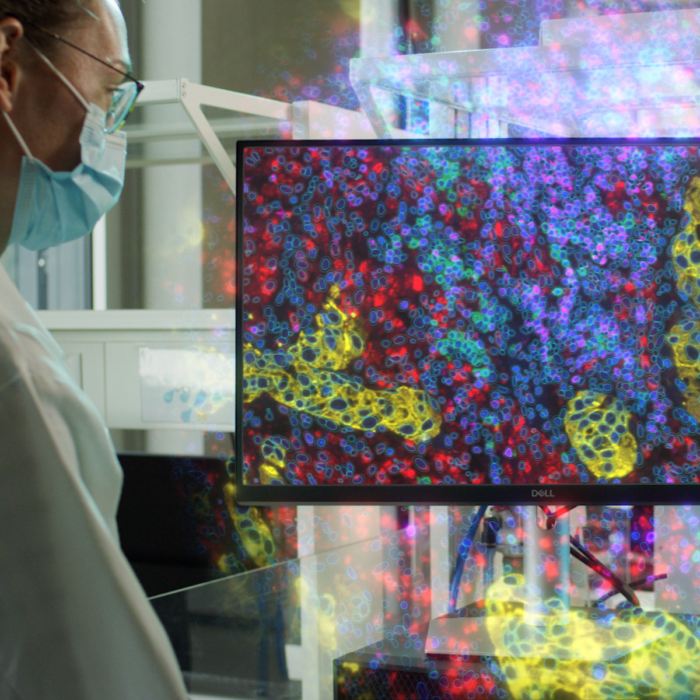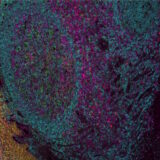Spatial Biology Education
The Spatial Biology Week™ 2022: the transforming power of spatial biology
Posted on:

In recent times, biomarker discovery and analysis have become top priorities for the biopharma industry. Biomarkers allow researchers to gain a deeper understanding of the immunity and diseases’ cellular relationships within tissues. Identifying predictive biomarkers signatures can enable a more accurate stratification of patients in order to select the best treatment options, ultimately improving patient outcomes and quality of care. Spatial biology is a powerful tool to extract a large amount of biomarker contextual information from tissue samples by creating a cell-by-cell map of multiple dimensions and deciphering complex cell interactions in a spatial context. We can already see the value of predictive biomarkers in the spatial field; however, their identification and clinical applications can be difficult and time-consuming.
Spatial biology analysis, and more specifically, multiplex tissue analysis, can be performed by a number of techniques. One of them is multiplex immunofluorescence (mIF), which is becoming increasingly popular with the rise of cutting-edge spatial biology innovation that enables many labs to access advanced technology. Improved treatment approaches will result from making spatial technologies mainstream among research labs by using more reproducible and user-friendly solutions to ease their technology adoption process. The discussion about when and how such technologies can be utilized in clinical settings will soon be on the horizon.
During The Spatial Biology Week™, we sat down with the field’s top experts to discuss the benefits of spatial biology as well as the reproducibility and flexibility requirements for any research setting.
Reproducibility is crucial for accurate spatial discoveries
A common theme throughout the virtual event was the criticality of data reproducibility: the ability to obtain reliable information is needed in all stages of research, from basic research – when screening for new biomarkers – to translational and clinical research – when analyzing large patient cohorts. Reproducibility eliminates variability and allows researchers to perform controlled experiments and obtain actionable data.
For example, Dr. Michael Surace, Director at AstraZeneca, said, “Reproducibility is one of those dark horse metrics. If you don’t have reproducibility, and you aren’t measuring it, you may indeed have a real challenge in the longitudinal comparison between samples, but you may be unaware of it.”
At the end of the day, if data cannot be reproduced, the research study will be stuck at square one. For this reason, a spatial analysis platform that offers high reproducibility is vital to delivering robust data for the demanding requirements of translational and clinical research, especially when it aims to be used in the routine diagnostics environment.
The spatial exploration of biomarkers requires flexibility
Throughout The Spatial Biology Week™ 2022, the expert speakers mentioned versatility and flexibility as key requirements for spatial biology platforms. For example, having the freedom to choose any standard antibody without the need to perform any upstream conjugations or barcoding, brings a great degree of flexibility and simplifies assay development. Another requirement for a flexible platform is to include detailed customization possibilities when creating protocols in order to run different types of assays, develop and modify biomarker panels adapted to specific research questions in short amounts of time, as well as provide standard file format outputs so that users can utilize any preferred software tools to analyze the data. All of these aspects are essential to facilitate the adoption and integration of these platforms into a lab’s workflow. Dr. Priyank Patel, Senior Scientist at Boehringer Ingelheim, said on Day 2 of The Spatial Biology Week™, “We really like that COMET™ is an open platform; it gives us a lot of possibilities to optimize antibodies based on our criteria and develop custom panels. It gives us flexibility in designing these panels too.”
Using platforms that allow researchers to design and optimize panels with their own antibodies can enable them to answer a wide range of scientific questions. As Dr. Charlotte Stadler, Co-Director of Spatial and Single Cell Biology Platform, Head of Spatial Proteomics at SciLifeLab, said on Day 3, “the possibility to work on flexible platforms can allow us to be more innovative.”
Setting the base for a new kind of gold standard
In any scenario where new technology is being developed and tested for future clinical diagnostic use, it will need to stand up to or surpass the current “gold standard” in order to succeed and be readily adoptable. In spatial biology, chromogenic single-plex immunohistochemistry (IHC) is the gold standard. Multiplex immunofluorescence (IF) has the potential to bring multiplex capabilities to the diagnostic environment one day. For this, IF will be directly compared to IHC to ensure that it is at least equal or superior when assessing biomarker expression. Therefore, the capability of running IHC or H&E on the same sample with IF allows the precise comparison and cross-validation of those assays and will ultimately help show the potential higher clinical utility of mIF. Furthermore, the novel sequential immunofluorescence (seqIF™) approach, which integrates repeated cycles of staining, imaging, and gentle, elution-based antibody removal steps, allows to maintain tissue integrity and perform further downstream applications.
In his talk on Day 5, Dr. Francois Rivest, Application Development Team Leader at Lunaphore, spoke about how IF testing on Lunaphore’s COMET™ platform compares in both sensitivity and specificity to IHC staining:
“We can make a comparison between a slide that we ran only for IHC or only on COMET™, but we can also take the same slide from the COMET™, run it directly for IHC staining, and compare the same cell expression for correlation. We can work on the quantification of the data to provide more numbers. From what we’ve observed, there’s an excellent correlation, and we’re confident we can provide the same conclusion at the end.”
With more supporting evidence, IF testing could become the new gold standard and has already become the staining method of choice for multiplex analysis.
Platform support, efficiency, and automation are key
While new and sophisticated technologies undoubtedly excite the research world, they must be user-friendly to be well incorporated into a laboratory. The level of automation and efficiency with which platforms can run assays, as well as the support to quickly resolve issues to not disturb workflow and timelines, are fundamental for the successful use of such platforms.
Dr. Alexander Klimowicz, Senior Principal Scientist, Immunology and Respiratory Discovery Research at Boehringer Ingelheim, also emphasized the usefulness of the capability of a platform to help look at larger amounts of varied data across different parts of a company’s pipeline: “we can develop one big panel and be able to capture most basic cell types all at once, and look at half of the portfolio at a time. We will not only be able to increase the efficiency of running these things concurrently, but we can also build differentiation between projects with similar mechanisms by looking at the cell types expressed in and the distinct pathologies they might be associated with. Thus, it provides invaluable early project support for us, and it provides it at a scale that enables us to support most of our portfolio instead of just specific parts of the portfolio. It is really valuable for our workflow.”
Using the COMET™ platform, laboratories can streamline their work and ultimately save time. In addition, the platform allows for automation with high throughput and enables the analysis of different spatial markers without user intervention. Dr. Rivest also reflected on this benefit of using COMET™: “You can run your protocol overnight and get the result in the morning. You can easily build and transfer assays. We have end-to-end automation; you can simply launch your protocol, walk away and get your result when it’s done.”
Related Articles
A high-plex road to biomarker development in a fully automated workflow
Posted on 22 Jun 2023
Read PostAssay development: how to overcome the challenges of TSA-based mIHC assays
Posted on 11 Oct 2022
Read Post
